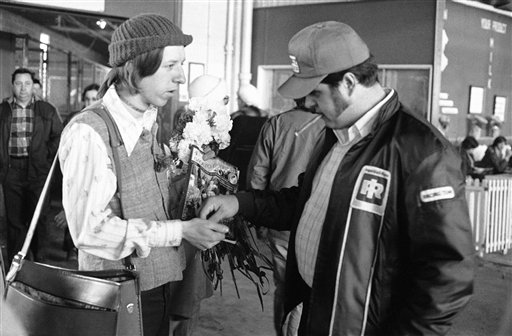In Heffron v. International Society for Krishna Consciousness, 452 U.S. 640 (1981), the Supreme Court upheld a content neutral time, place, and manner regulation that placed restrictions on the religious practices of the Krishna sect against allegations that it restricted the First Amendment exercise of religion.
Minnesota prohibited distributions at the state fair outside designated booths
A Minnesota regulation prohibited anyone at the Minnesota state fair from selling or distributing any written material except from designated, fixed-location booths. Because Krishna religious doctrines commanded its members to go out into public places and distribute their religious material, the International Society for Krishna Consciousness challenged this regulation, arguing that it restricted their religious practices.
Court said state fair regulation was content neutral
Writing for a 5-4 majority, Justice Byron R. White characterized the state fair regulation as a content neutral time, place, and manner regulation. According to White, the regulation did not discriminate; it forbade every person and organization from distributing literature or soliciting donations except from a fixed booth. As such, this regulation was subject to a lower standard of review than would be applied to content based regulations.
Unlike the strict scrutiny test, content neutral time, place, and manner regulations only had to be supported by a significant state interest and leave open ample alternative channels for communication of the information. White found that the significant state interest was the need to maintain the orderly movement of the huge crowds of people attending the state fair and access to alternate forums was not denied without or within the fairgrounds. The concept has become known as the Heffron principle, and has been applied in many free speech cases since then.
Dissenting justice said restriction burdened First Amendment rights
Writing in dissent, Justice William J. Brennan Jr. argued that in subjecting proselytizers to arrest and removal from the fairgrounds, the restriction on distributing literature substantially burdened First Amendment rights. Brennan also asserted that the regulation was an overly intrusive means of achieving the state’s interest in crowd control and that the state had not shown that a relaxation of the booth rule “would create additional disorder in a fair that is already characterized by the robust and unrestrained participation of hundreds of thousands of wandering fairgoers.”
This article was originally published in 2009. Patrick Garry, JD, PhD, is a professor of law at the University of South Dakota School of Law. Professor Garry’s books on the First Amendment include Scrambling For Protection: The New Media and the First Amendment, An American Paradox: Censorship in a Nation of Free Speech, and Limited Government and the Bill of Rights.

